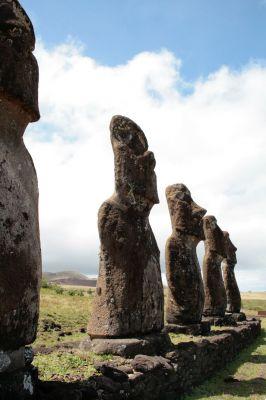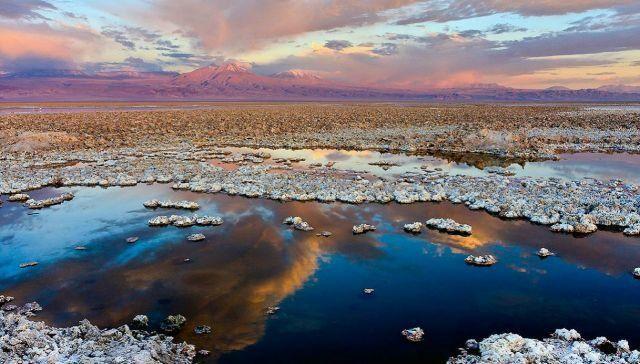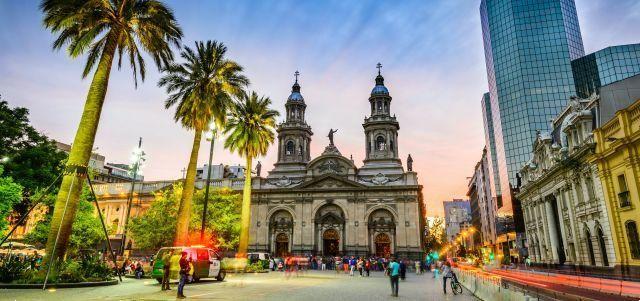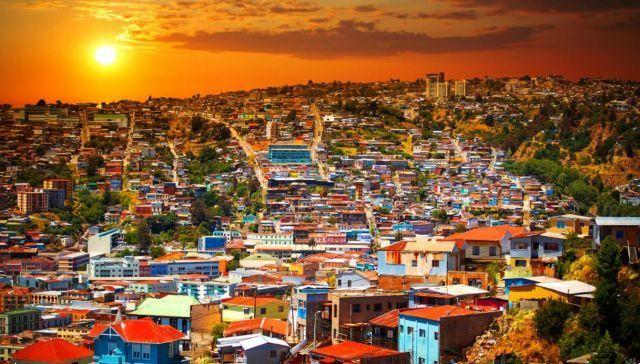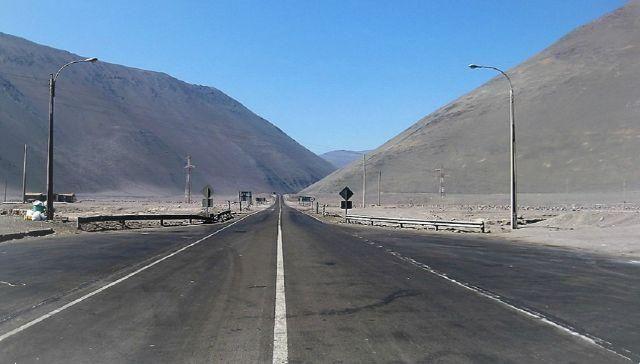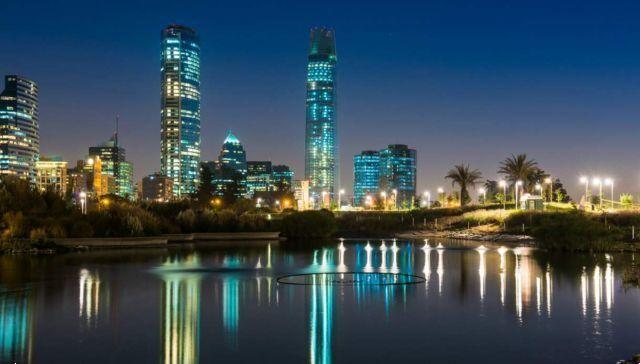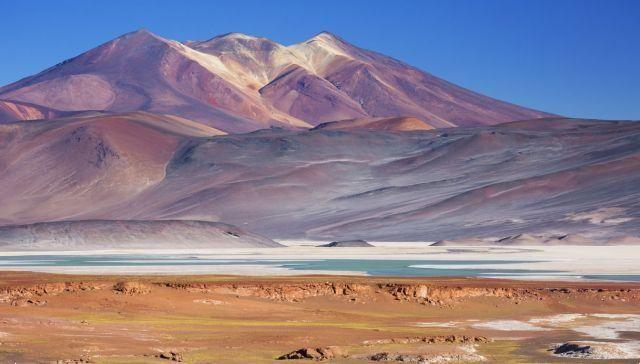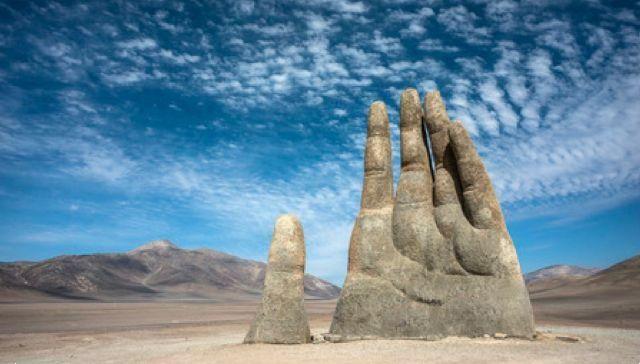Lonely Planet also considers the trails of the Chilean Patagonia among the best in the world for trekking. In this article I try to give you all the useful information for to organize
a trek in the Torres del Paine National Park of one or more days.
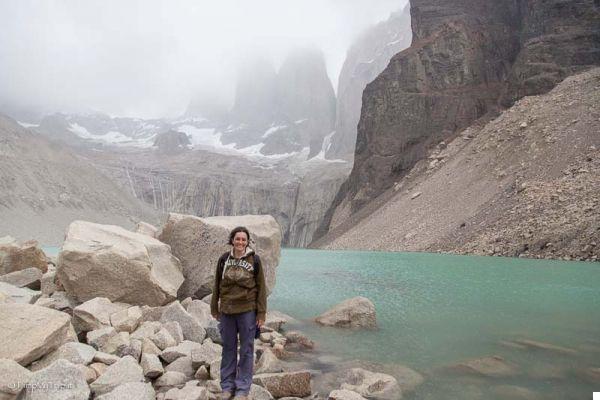
Important! Before venturing to travel the circuit W (the most famous in the Park) or other trails make sure you are in good health and have travel insurance.
On this trip I had, as always, the World Nomads insurance coverage.
Organize a trek to Torres del Paine National Park
Since this is a long post in which I have tried to gather all the essential information, I have broken it down into chapters. Below you will find the list, click on the link and go directly to the section that interests you.
- What to bring: tents and backpack, clothing and essentials
- How to get there and how to move around the Park
- Campeggi and Refuges
- Trekking in the Park: trekking W, Circuits O and Q
- Essential maps and recommended guides
What to bring
Go for a trek to the Torres del Paine it means not only observing grandiose scenarios, but also being prepared to find all 4 seasons in one day. The weather here changes very quickly and it is not uncommon even in the summer months to meet sun, rain or, worse, snow.
It is therefore necessary to take great care to put the right things in the backpack to be ready for any eventuality, but being careful not to put too much weight on your back.
If you intend to eat in the refugios you will already save a lot of weight, as well as for food also for any stoves, plates and dishes that you can do without.
Another tip is to try to bring technical clothing that is warm and light and that remains dry. By now technology has made great strides and the market offers a wide choice.
However, remember that these tips are indicative, because to know what to bring you also need to know how long the trekking will last, in which season you will decide to go and if you will choose routes suitable for everyone or more difficult, perhaps with some rock climbing.
Tent and Backpack
The tent will be, if you don't already have one, the hardest choice. Given the climate and the infamous Patagonian wind (not joking, it also blows at more than 100km / hour), the tent must be technique e resistant, But also the as light as possible because everything you put on your back will be an extra burden to carry.
Be careful even if you rent it not to be given something that weighs too much. I really like them super light curtains by MSR, I have always, even in the past, found myself very well and I feel I can advise you.
The mattress if you sleep in a tent is essential and absolutely essential. If you walk for many hours, especially in the mountains, you need to rest well to have clarity and attention. In addition, finding yourself in the morning with a bad back pain is not exactly the best of life if you have to walk even ten hours.
Sleeping bag issue. There are so many on the market that you can't help but find the right one. Serious brands have written the minimum and maximum temperatures at which it should be used. Here, too, I choose quality things, take a 10 euro sleeping bag and then don't sleep a wink at the cold, no I don't even think about it.
In addition, the mattress, in addition to making us sleep comfortably, is an insulator between us and the ground and prevents humidity from causing us discomfort. I have a self-inflating one from Thermarest, but there is something for all tastes.
Even in the case of the mattress, therefore, it is better to focus on something more expensive and of quality rather than aiming for savings. Walk on the Torres del Paine trails it is not like taking a trip to the sea or staying a few days at the campsite in Marina di Pisa, you are in an environment that can become difficult and hostile and you have to go prepared.
The backpack is also very important. For a trek like the W or Circuit O, choose one that fits comfortably on your back. Try it first, perhaps in the store. Better a backpack that has many pockets to store various things, but that is balanced when you wear it.
Also equip yourself with a waterproof backpack cover: the backpack itself does not suffer from the water, but arriving in the evening dead tired and discovering that you have nothing dry to wear could be very very annoying.
Also essential is a backpack to wear for day treks in which to store the things you absolutely need.
Clothing
Since the weather is very difficult in Patagonia, choosing the right clothing is a winning but tiring choice.
If instead of going in the summer (October / April) you will go in the winter months (June / August), you will have to be prepared for anything: even if the park remains open, many campsites and refugios are closed and since there is no maintenance, the trails are very difficult to find under the snow. If you still decide to go, make sure you are well prepared and get in touch with CONAF.
As a guideline, a backpack for trekking W or in any case a multi-day excursion should not weigh more than 13-14 kg.
After making and redoing the backpack in the end I I have reduced to the essentials wearing only two sets of clothing, technical, warm and light:
- 2 t-shirts, one with long sleeves and one with short sleeves
- 2 thermal tank tops
- 1 pair of hiking pants
- 1 pair of thermal pants to possibly put under the others and with which I slept
- 1 fleece under jacket
- 1 light duvet
- 1 windproof and rainproof jacket
- hiking boots
- 3 pairs of socks
- 2 seamless underwear suits, so they don't bother me while walking.
- Gloves, scarf and cap
Eat and drink
Before starting trekking in Patagonia I had no idea that there were certain strategies for eating and drinking.
In my backpack I had the usual things that one takes to the mountains: water bottle, biscuits, chocolate and dried fruit. It is true that I have never prepared myself to eat, preferring to go to the refugios and to the restaurant.
On the other hand, I discovered precisely in Patagonia, observing boys who were trekking for even 9 or 10 days, that there are gods dehydrated foods that can be purchased both online both locally (but they charge you more for them). They are not even that bad in taste, in fact the ones from the Mountain brand are good and also they are easy to transport and very easy to prepare.
With all the rivers and streams in the Park, finding something to quench your thirst and refilling your water bottle is not difficult. However, given the influx of undisciplined people who do not follow the rule of not washing the dishes or, worse, carrying out their needs near the streams, it is better to be cautious and bring some tablets to disinfect the water, you find them here on Amazon.
Other indispensable things
Other absolutely essential things to bring are:
- water bottle: there are all the materials… I prefer a plastic water bottle because it is light when empty.
- Sun glasses.
- protective cream.
- donkey di cacao.
- head torch.
- small first aid: especially patches for blisters, a cortisone stick for insect bites, disinfectant and tweezers to remove any splinters.
How to get there by public transport and how to move around the park
Generally the starting point for going to the Torres del Paine National Park is the small town of Puerto Natales which is located 112 km to the south.
There are coaches and buses that every day guarantee a transfer service to the Park with numerous trips that depart from the city bus terminal.
Tickets for the bus can be purchased or directly at the counters of the various companies inside the bus terminal (cheaper option on average around 15.000 CLP
around 20/22 euros round trip) or in agencies and hostels (prices may vary, on average they cost around 18.000 CLP).
The buses leave every day from the bus station at 7,30 or 14,30 and take about 2 hours e
half to get to the main entrance of the park (Laguna Amarga).
After the Laguna Amarga the buses also stop in Pudeto (about an hour later) from where
you can take the ferry to Paine Grande and then to the Park Administration.
The major bus companies that operate the service between Puerto Natales and the
Park are: Buses Gomez, Buses Fernandez, Buses Maria José and Bus Sur (which also offers a transfer service from Punta Arenas).
Getting around in the park
Inside the park there is a ferry that goes from the bus stop to Pudding leads to the campsite / refuge Paine Grande.
The cost of the catamaran is 15.000 CLP one way (20-22 euros), while the price
it reduces a lot if you take the return ticket (30-33 euros).
From the entrance to the Laguna Amarga there are shuttles that take you to theSightseeing, starting point for trekking.
A fast boat service, organized by Refugio Gray, leads from the dock on Lake Gray to the refugio. Costly.
Campeggi & Shelters
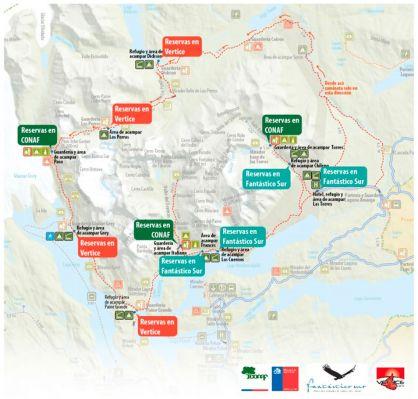
If you want to save your wallet a little the only way is to bring your own tent or rent one to Puerto Natales. In fact, here it is possible to rent practically everything you need, from tents to stoves, so it is not absolutely necessary to bring things from home.
Beware that in the Torres del Paine National Park it is absolutely forbidden to light fires, but it is only allowed to do so in the designated areas in the campsites and refugios. The same thing also applies to smoking.
Shelters
Please note:: book well in advance as refugios fill up much earlier especially in high season.
The refugios are managed by two agencies: Fantastic Sur (che gestisce i shelters Los Cuernos, El Chileno, Torres, El Frances, Seron) and Patagonia Summit (Paine Grande, Gray) and the larger ones offer services such as electricity, a bar service and wi-fi (slow and very expensive).
Refugios, even though they are spartan accommodations, are expensive.
A bed in a shared dormitory (excluding breakfast) can cost from 30 to 60 euros each but even more. For breakfast, if you don't bring your own things, charge another 10 euros.
It may sound crazy, but you think that carrying supplies is not easy and this is why food costs so much. In fact, food is brought on horseback. This is one of the reasons for the absurd prices, it has its own logic.
If you do not bring your own sleeping bag (also rentable, but I like to bring mine I find it more hygienic) you can rent it directly in the shelter together with the sheets, but for this you pay an extra.
Free campsites
In a place where they practically charge you for the air you breathe, being able to sleep in a free campsite doesn't even seem real. Too bad that they are very few and that in any case being far from each other if you want to do the trekking of the W or the O circuit it is necessary to stay in one paid in the middle but it is always better than nothing.
However, free campsites do not have many services, indeed practically none. Generally there is a covered area where you can cook and the toilets (congratulations!).
They are often very crowded (who knows why since they are free), it is tight and it is therefore smart to arrive early to try to grab the best seats.
From October 2015 it is mandatory to book: you can do it either at the CONAF office (forestry agency of Chile) in Puerto Natales, or through the online booking system.
This is the list of free campsites inside the Park:
- Camping Towers
- Camp Paso
- Camp Las Carretas
- Camp
There are actually two others, the British and the Japones but they are only for experienced climbers with a certain license.
A important consideration: from the campsites, when you leave, you have to take your garbage away and, if you want to wash the dishes, do it away from the stream. Take this seriously and if you see any undisciplined people who don't follow the rules, let them know! The environment is really delicate and it is necessary (as well as mandatory as dictated by the rules of the Park) to protect it.
Paid campsites
Paid campsites are also, like the refugios managed by Fantastico Sur and Vertice Patagonia (these obviously know how to do business).
Paid campsites are of two types, those attached to refugios and those that are not. The only difference is that in the former you can use the services of the refugios and are therefore more expensive. In these, therefore, you will have electricity to charge the batteries of cell phones and cameras, bathrooms and showers, a bar and a small shop where you can stock up on primary goods.
In addition, even here you can rent tents, sleeping bags and mattresses.
Due to the fact that in recent years the influx of people to the Park has increased dramatically, the advice is to always book even if you are in low season, so much so as not to take risks. When booking, you will have to say exactly what day you want to stay. In short, like in a hotel.
If you book in advance there is a discount for campsites managed by Patagonia Summit.
Below you will find the list of campsites with indicative prices (low / high season, per person per night).
- Refugio Paine Grande, Summit (7000 CLP = 9 €)
- French Camp (8500/9500 CLP = 13 €)
- Los Cuernos Refuge (7500/8500 CLP = € 11)
- Refugio Chileno (reservations required 7500/8500 = 11 €)
- Camp Serón (8500/9500 CLP = 13 €)
- Refugio Dickson, Vertice (6000 CLP = 8 €)
- Los Perros Camp, CONAF / Vertice (6000 CLP = 8 €)
- Refugio Gray, Vertice (6000 CLP = 8 €)
- Torres / Central Camp (8500/9500 CLP = 13 €)
Trekking W and Circuit O
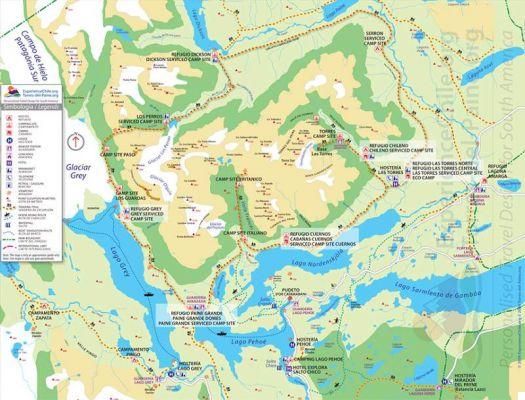
Map of the W trek and O credit circuit http://www.torres-del-paine.org
Il Trekking W it is by far the most popular trek. especially in high season it is very crowded so the advice given above is always valid: book first where to sleep. If you go in high season, book much earlier.
The route covers the main points of interest in the Park: the Gray glacier French Valley and the homonymous glacier and at the end the gem of the Park: le 3 towers of the Paine.
Most people do it in 5 days and they do well if they enjoy it much more, but if you are strong walkers then you can do it in just three days.
Below you will find a relaxed 5-day itinerary, which starts with a nice boat ride on Lake Gray and ends with a bang: the 3 Paine towers at dawn! In fact, the W trek is practicable both from East to West and from West to East, but my advice is to do it in this sense.
Trekking W in 5 days (100 km, 72.000 CLP)
Day 1: From Puerto Natales to the Gray Refuge (11 km)
Leave Puerto Natales early in the morning and once you enter the park continue by bus to Pudeto from where the catamaran that takes you to Paine Grande departs. Once you get off the catamaran, follow the path that flanks the lake to the refuge (travel time 3/4 hours)
Day 2: Gray Glacier - Paine Grande (11 km + 8)
In the morning, if you wake up early, go up to el Paso to have beautiful views of the glacier. go back to the Gray refugio and grab your stuff, scan and go back to the Paine Grande where you can stop for the night.
Giorno 3: Valle del Frances - Los Cuernos (28 km)
This is probably the hardest day of all. Wake up early and arrive at Campamiento where you can drop your stuff. Continue to Mirador Frances and from here then go back, pack your things and proceed to Los Cuernos. You should arrive around 17.30 (travel time 8/9 hours)
Giorno 4: Los Cuernos - Torres Camp (20 km)
Today's route is really beautiful as it mostly runs alongside Lake Nordernskjöld. at the crossroads take the detour towards the Chileno Refugio, pass it and pitch your tent 1 hour further on at Campamento Torres.
Go to sleep early, the next day you will be up early!
Day 5: Torres del Paine - Puerto Natales (23 km)
wake up early. From Campamento torres to the 3 Torri del Paine there are about 45 minutes of uphill walking. This means that, since in summer the sun rises around 6 in the morning, you will have to get up around 4,30, prepare your backpack for breakfast and try to arrive at the 3 Towers just before sunrise.
This will truly be the best thing of the whole W. trek. After the show, go back to the camp, pick up your stuff and go down to the Hotel Las Torres. From here, take the shuttle that will take you back to the park entrance on the Amarga Lagoon and from there the bus to Puerto Natales.
Circuit O (130 km) and Circuit Q
Il Circuit O it runs through the entire W trek and passes behind the Paine Towers to form a ring. The people who walked it said that the "behind" part, that is the one not included in the W, is very very beautiful, with breathtaking scenery and few people. You can easily do it on 7/8 days. Be aware that sometimes the passage on the Paso John Garner is closed due to wind or poor visibility.
To travel the circuit O to the trekking W you can add the following stages:
Giorno 1: Puerto Natales - Serón Camp (12 km)
Get off the bus at the park entrance and start walking until you reach the Serón camp.
Day 2: Campamento Serón - Refugio Dickson (18 km)
Leave early enough to enjoy the beautiful drive up to Lake Dickinson. on the lake you will find the camp with the glacier behind it.
Giorno 3: Dickson Refuge - Los Perros Camp (11 km)
One of the most beautiful routes of all the circuit, it develops between forests, waterfalls and viewpoints. Shortly before reaching the camp you will arrive at the Mirador Britanico from which there is a breathtaking view of the Los Perros glacier and the glacial lake. Take your time to admire the view, the campsite is only about fifteen minutes from here.
Giorno 4: Camp Los Perros - Paso (12 km)
Get up early. even if the km are not many, this part is difficult above all because you walk on the rocks and often a very strong wind blows on the pass.
Day 5: Paso - Refugio Gray - Paine Grande (21 km)
From Paso reach the Gray Refuge and from here start trekking W.
Il circuit Q it is the Circuit O plus a piece of trail that connects the Serano Visitor Center with and the Refugio Paine Grande.
Books, maps and useful guides
Here I recommend some books that I read before leaving, but above all some guides and trail maps that are absolutely essential. You can also buy them directly there but they cost you more than buying them online first, as well as if you buy them before you could study all the stages of your trekking well.
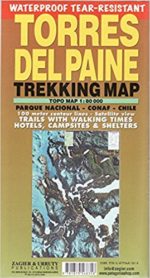
Torres del Paine Trekking Map
A map with all the trekking paths in the Torres del Paine National Park.
I used this map to organize my treks, it is also waterproof so you can easily carry it in your backpack.
Buy it on Amazon >>
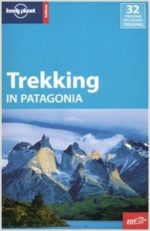 Trekking in Patagonia - Lonely Planet Edition (English)
Trekking in Patagonia - Lonely Planet Edition (English)
An indispensable guide for those who want to trek not only to Torres del Paine, but throughout Patagonia
Buy it on Amazon >>
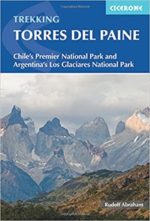
Trekking Torres del Paine
Eight treks in Torres del Paine National Park and Los Glaciares National Park, including Trekking W and Circuit O.
In addition, many other one-day treks and excursions from Puerto Natales and El Calafate are also described.
Buy it on Amazon >>
You liked this article on how to organize a trekking to Torres del Paine? Do you have any other tips? If you do leave me a comment!
Disclaimer: This post uses affiliate links. Buying through my links you pay nothing more, but I get a small percentage that allows me to keep this blog alive. Thanks!




